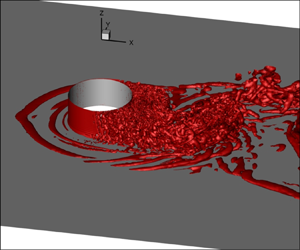Published online by Cambridge University Press: 08 November 2021

Large eddy simulation of flow past a circular cylinder of low aspect ratio ( $AR=1$ and
$AR=1$ and  $3$), spanning subcritical, critical and supercritical regimes, is carried out for
$3$), spanning subcritical, critical and supercritical regimes, is carried out for  $2\times 10^3 \le Re \le 4\times 10^5$. The end walls restrict three-dimensionality of the flow. The critical
$2\times 10^3 \le Re \le 4\times 10^5$. The end walls restrict three-dimensionality of the flow. The critical  $Re$ for the onset of the critical regime is significantly lower for small aspect ratio cylinders. The evolution of secondary vortex (SV), laminar separation bubble (LSB) and the related transition of boundary layer with
$Re$ for the onset of the critical regime is significantly lower for small aspect ratio cylinders. The evolution of secondary vortex (SV), laminar separation bubble (LSB) and the related transition of boundary layer with  $Re$ is investigated. The plateau in the surface pressure due to LSB is modified by the presence of SV. Proper orthogonal decomposition of surface pressure reveals that although the vortex shedding mode is most dominant throughout the
$Re$ is investigated. The plateau in the surface pressure due to LSB is modified by the presence of SV. Proper orthogonal decomposition of surface pressure reveals that although the vortex shedding mode is most dominant throughout the  $Re$ regime studied, significant energy of the flow lies in a symmetric mode that corresponds to expansion–contraction of the vortex formation region and is responsible for bursts of weak vortex shedding. A triple decomposition of the time signals comprising of contributions from shear layer vortices, von Kármán vortex shedding and low frequency modulation due to the symmetric mode of flow is proposed. A moving average, with appropriate size of window, is utilized to estimate the component due to vortex shedding. It is used to assess the variation, with
$Re$ regime studied, significant energy of the flow lies in a symmetric mode that corresponds to expansion–contraction of the vortex formation region and is responsible for bursts of weak vortex shedding. A triple decomposition of the time signals comprising of contributions from shear layer vortices, von Kármán vortex shedding and low frequency modulation due to the symmetric mode of flow is proposed. A moving average, with appropriate size of window, is utilized to estimate the component due to vortex shedding. It is used to assess the variation, with  $Re$, of strength of vortex shedding as well as its coherence along the span. Weakening of vortex shedding in the high subcritical and critical regime is followed by its rejuvenation in the supercritical regime. Its spanwise correlation is high in the subcritical regime, decreases in the critical regime and improves again in the supercritical regime.
$Re$, of strength of vortex shedding as well as its coherence along the span. Weakening of vortex shedding in the high subcritical and critical regime is followed by its rejuvenation in the supercritical regime. Its spanwise correlation is high in the subcritical regime, decreases in the critical regime and improves again in the supercritical regime.